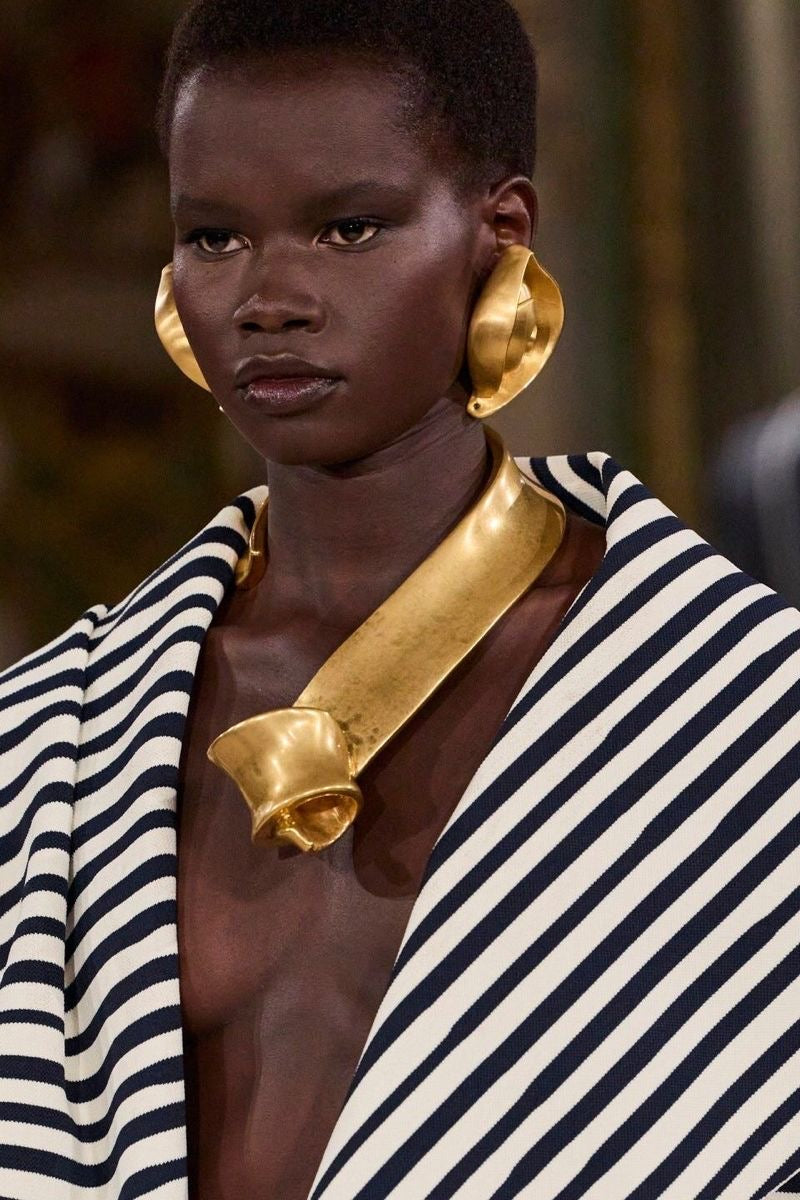
Gold and Identity: African Jewelry from Tradition to Today
Share
Introduction
In bustling Bamako markets, under the shade of ancient baobabs, as much as in the gilded streets of Lagos or the elegant showrooms of New York, gold tells a story spanning centuries. African gold jewelry is more than decoration: it is history worn on the body, a symbol of power, identity, and collective memory. From the gold-rich soils of West Africa to the showcases of contemporary diaspora artisans, gold retains its magic and cultural weight, linking past and present.
1. Gold as a Mirror of African Civilizations
Since antiquity, West Africa has been renowned for its gold. The Ghana Empire, flourishing in the 8th century, thrived on gold trade reaching European and Middle Eastern markets. In royal courts, kings adorned themselves with massive necklaces and finely crafted bracelets, signaling wealth and divine legitimacy.
Mansa Musa of Mali, the legendary 14th-century emperor, traveled with caravans brimming with gold, spreading the empire’s shine far and wide. Jewelry from this era was exquisitely detailed: pendants, rings, and crowns featured motifs inspired by nature and mythology, telling stories of ancestors, tribes, and kingdoms.
In the Kingdom of Benin, gold plaques and necklaces illustrated myths, honored ancestors, and reflected social hierarchy. Each piece was more than ornamentation—it was history engraved in precious metal.
2. East African Traditions
The Swahili Coast, spanning Kenya and Tanzania, boasts a rich jewelry tradition. Artisans combine metalwork and beadwork, reflecting trade links across the Indian Ocean. The Akamba people of Kenya are renowned for their intricate metal jewelry, while Tanzanian goldsmiths incorporate symbols of spiritual and social significance.
Contemporary designers such as Adele Dejak (Kenya) and Swahili Coast Design collaborate with local artisans to create pieces that honor East African heritage while appealing to global audiences. Museum exhibitions, like World on the Horizon: Swahili Arts Across the Indian Ocean, preserve these traditions and educate the public on the cultural significance of East African adornments.
3. Social and Spiritual Roles of Jewelry
Gold in Africa carries significance beyond material value. It marks social status, rites of passage, and religious ceremonies. Among the Ashanti of Ghana, jewelry did not simply decorate; it communicated. The shape of a necklace or size of a ring could indicate whether the wearer was noble, a warrior, or a royal advisor.
In many cultures, gold jewelry protected newborns or accompanied the soul in spiritual rituals. Symbols depicted sacred animals, fertility signs, or stories of courage and wisdom, transforming jewelry into vessels of cultural narrative.
4. The Diaspora: Transmission and Adaptation
The story of African gold jewelry extends far beyond the continent. Across Harlem, Paris, Rio, and London, gold continues to convey identity and heritage. Descendants of Africans—through the legacy of slavery or migration—have found in these pieces a tangible connection to their roots.
Contemporary designers like Ohema Ohene (Ghana), Adele Dejak (Kenya), and Mami Wata Jewelry reimagine ancestral motifs for modern wear. Celebrities such as Lupita Nyong’o, Beyoncé, and Naomi Campbell have worn African-inspired gold jewelry, increasing its visibility and inspiring new generations.
Boutiques and galleries, from Galerie Zurcher in Paris to The Jewelry Room in New York, showcase historical and contemporary African pieces. Festivals such as African Fashion Week London, Lagos Fashion & Design Week, and Harlem Week celebrate artisans and keep traditions vibrant in contemporary contexts.
5. The Importance of Preserving and Perpetuating the Gold Culture
Gold jewelry in African cultures is not just a material of beauty—it is a symbol of identity, continuity, and resilience. Preserving this tradition matters for several reasons:
- Cultural Heritage and Identity – Jewelry preserves ancestral stories, symbols, and values, connecting wearers to their lineage. For the diaspora, it is an act of remembering and reclaiming heritage.
- Empowering Artisans and Local Economies – Supporting gold jewelry artisans sustains craftsmanship and livelihoods, keeping skills relevant across generations.
- Education and Storytelling – Jewelry is a living museum. Each motif teaches history, spirituality, and societal values.
- Global Influence and Cultural Dialogue – As African-inspired gold appears internationally, it encourages younger generations to appreciate tradition while innovating.
Perpetuating the gold culture ensures that these pieces remain more than adornments—they become statements of resilience, pride, and identity.
Reader’s Guide: Explore African Gold Jewelry
Contemporary Designers & Artisans
- Ohema Ohene (Ghana) – Modern Ashanti-inspired designs.
- Adele Dejak (Kenya) – Bold brass and gold-plated jewelry blending African heritage with contemporary fashion.
- Swahili Coast Design – Eco-friendly brass jewelry crafted with East African artisans.
- Mami Wata Jewelry – Inspired by West African mythology and folklore.
Boutiques & Galleries
- Galerie Zurcher (Paris) – Exhibits historical and contemporary African jewelry.
- The Jewelry Room (New York) – Curates unique African-inspired pieces.
- Soko by Baobab Fare – Ethical, handcrafted jewelry from Rwandan artisans.
- African Heritage House (Kenya) – Preserves traditional jewelry making and storytelling.
Festivals & Cultural Events
- African Fashion Week London – Celebrates African fashion and jewelry.
- Lagos Fashion & Design Week – Showcases contemporary African designers.
- Harlem Week – Features African artisans and jewelry exhibitions.
- World on the Horizon: Swahili Arts Across the Indian Ocean – Museum exhibition highlighting East African jewelry traditions.
